Seat belt use in Buenos Aires, Argentina: a 14-year-old struggle
ABSTRACT
“Luchemos por la Vida” is a non-governmental, non-profit organization, oriented towards public good. It works to prevent traffic accidents in our country, Argentina, where chaotic, irregular, and deadly traffic caused 7,137 deaths last year, more than 100,000 injuries ranging from light to serious, thousands of handicapped people and appalling material losses which add up to 10 billion dollars annually according to our estimates. The traffic accident fatality rate is 7 to 10 times higher than that of developed countries when we consider the number of vehicles circulating in Argentina (estimated at 6,440,000). Our goal, at “Luchemos por la Vida”, is to prevent traffic accidents in order to reach as soon as possible a point where we may see what now seems an utopia come true: no more traffic accident fatalities in our country. Significantly, "Luchemos por la Vida" means "Let's fight for life".
Within this context, in 1990, when the association had just been started, we launched our first poster, to promote seat belt use. Since then, we have undertaken a difficult task which is twofold: on one side, a strong, ongoing campaign on TV and radio, aimed at the general public, in order to create awareness about the benefits of seat belt use, which has been on the air for 14 years.
On the other side, our efforts were focused on the passing of a seat belt use law, which was finally passed quite easily and fast; but then, having authorities enforce that law is what has always been more difficult to achieve. At the end of 2004, our efforts started to pay off: enforcement helped raise seat belt use in Buenos Aires to 86% for private cars. But we are in danger of seeing those numbers drop as enforcement is once more forgotten. If that control is reinstated in Buenos Aires, it will soon extend itself to the rest of the country, and that could help save 1,000 lives a year.
SEAT BELT USE IN BUENOS AIRES ARGENTINA: A 14-YEAR-OLD STRUGGLE
INTRODUCTION
“Luchemos por la Vida” is a non-governmental, non-profit organization, oriented towards public good. It strives to prevent traffic accidents in our country, Argentina, and to achieve as soon as possible what many would consider utopian: that no more people die in our country as a result of traffic accidents. Significantly, "Luchemos por la Vida" means "Let's fight for life".
A chaotic, irregular, and deadly traffic caused 7.137 deaths last year, more than 100,000 injuries ranging from light to serious, thousands of handicapped people and appalling material losses which add up to 10 billion dollars annually according to our estimates, (this is in proportion to losses in other countries, for instance USA, $230.6 billon in 2000 (NHTSA, 2000 and Rune Elvik, 1991).
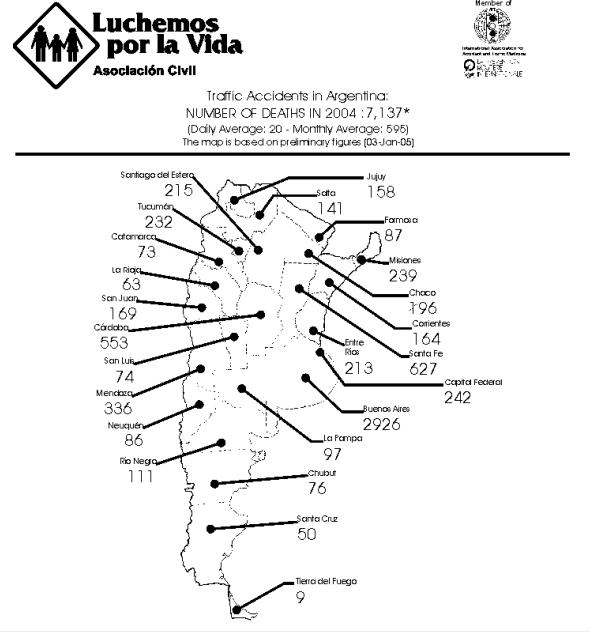
The traffic accident death rate is 7 to 10 times higher than that of developed countries, when we take into account the number of vehicles circulating in Argentina (estimated at 6,440,000, ADEFA, 2003)
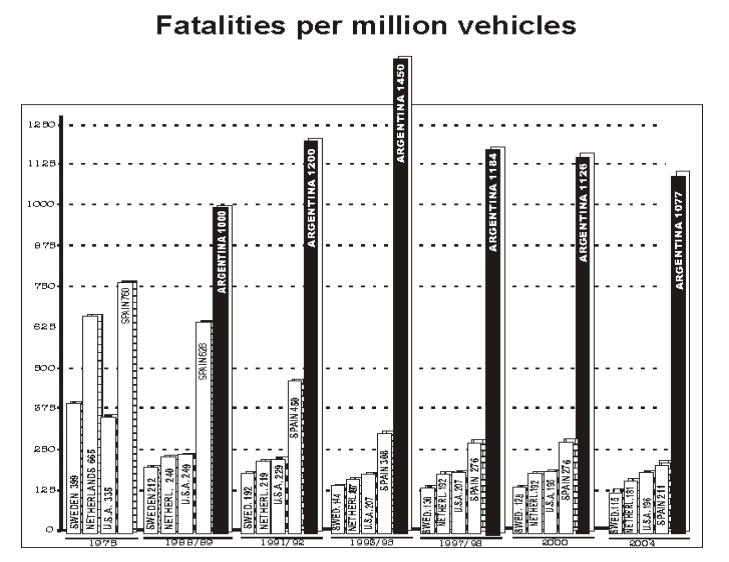
But this terrible situation, which has been repeating itself over the last years, as you can see in the transparencies we are watching now, doesn’t happen “by accident,” if I may use the term. It is the consequence of anarchy in traffic caused by public officials who show no concern, and the indifference of the majority of people. Both groups are unaware of the seriousness of this situation.
From its very first day, this association has worked very hard to press for the use of seat belts in Argentina, as part of its mission to save lives from traffic accidents, and according to all previous research which advices to establish seat belt usage compulsory as an effective way of saving lives (-Evans L. 1987, -R. Andréasson 1990, -B.J. Campbell 1990, -M. Mackay 1991, and later -NHTSA. 1996 and Claes-Bäckström 2000).
These were the steps and the corresponding results:
In 1990, when the association had just been started, we launched our first poster, to promote seat belt use. Simultaneously, we carried out the first measurement of the number of people effectively using them. At that time, this figure was practically zero.
Most drivers didn’t know what seat belts were for and many tied them behind the seat, so they “didn’t bother.” By then, when we made our first measurement, only 0.2% used seat belts in the city of Buenos Aires, capital and the most important city of Argentina (3,000,0000 inhabitants).
As soon as we had the possibility of broadcasting messages on traffic safety on TV and radio, seat belts were the topic of one of the first four spots and they were also mentioned in the second clip on TV in mid-1992.
At the same time, we began to be invited to TV and radio programs where seat belts were the central and repeated topic, in spite of the surprise and lack of information of journalists and audiences.
In our first visits to the national authorities asking for solutions to the serious problem of traffic accidents, we continuously stressed the need to make seat belt use compulsory, at least in front seats. A terrible accident that happened in April 1992, triggered a new traffic legislation that picked up “Luchemos por la Vida”’s project on compulsory use of seat belts. At that stage, only 3.1% used seat belts (compare this rates to the ones of other cities at the same year, for instance Los Angeles 56%, San Francisco 55%, according to Brian O´Neill, Insurance Institut for Traffic Safety, 1993).
On July 1, 1992, seat belt use became obligatory in Argentina, both in front seats as well as in rear seats, and usage climbed to 32% without any kind of enforcement.
Unfortunately, the impact of the new legislation soon disappeared due to the total lack of enforcement. However, in November 1992, faced with the insistent demands of many people and institutions, including Luchemos por la Vida, the Chief of Police announced that “the following day they would control seat belt use, and there would be penalties”. Usage rate went up to 36%.
But this was short-lived. Seat belt use was never controlled seriously, not on the following day nor ever, in spite of our many demands, so this was left to each person’s decision and the sole influence of our association’s growing campaign.
Table 1 shows the figures for seat belt use since November 1990, year by year, according to our measurements. The slight increases in usage coincide in general with our campaigns on TV and radio.
METHODS
The number of deaths in Argentina was computed at the time of or as a result of the accident, within the 30 days following, according to the most generally accepted international criteria. The numbers given are the most recently obtained (official data, mostly given by the Police or Municipalities). As many of the original figures only include deaths at the time of the accident, those were adjusted according to the internationaly accepted rates, in order to obtain a serious appraisal , study and comparison of mortality in road accidentology in Argentina.
The usage of seat belts in the city of Buenos Aires for every period included in this research, was surveyed directly on vehicle occupants following a programmed comprehensive schedule covering different sites of the city, both at day and night times, holidays and working days, different types of vehicles, etc. At least 4,000 vehicles were surveyed each time.
But 1998 was the year during which “Luchemos por la Vida” decided to step up actions – according to its possibilities (Luchemos por la Vida NGO is the main player in Argentina as regards to traffic safety campaigns and education, according to Interamerican Developing Bank, 1998) – aiming at increasing awareness of the benefits of using seat belts among the highest possible number of people, on the one hand, and trying to get authorities to understand once and for all that making seat belt use compulsory could save many lives.
Since it would be very long to indicate all the actions that have been carried out since 1990, I will simply detail those accomplished in the campaign we launched starting May 1, 1999, to date.
The campaign we launched on May 1st was designated “Let’s save 1,100 lives by using the seat belt.”
So we started with a very intense TV and radio campaign, based on the objections, myths and false beliefs of the majority of the population regarding the use of seat belts, and providing information on the consequences of not being buckled up in case of an accident, as well as the benefits of wearing seat belts.
TV and radio clips were, and still are, widely shown daily since that date in the 5 most important TV channels in Argentina (three times a day average in each) and in around 40 TV channels in the provinces, as well as in the 13 most important national radios and 200 more radios in the interior (Mercado (1993)).
Airing these clips has been provided for free – and continues to be so - in the majority of cases thanks to help received from the media, free of charge.
We sent 25 certified letters to the President and to each one of the Governors, stressing their responsibility in the 1,100 deaths every year, inasmuch as they did not control seat belt use, and asking them also to provide a good example in using them themselves (because in our country, authorities, in general, don’t comply with the Seat Belt Law).
We sent 1027 letters to each one of the city mayors in the country similar in nature to those sent to the governors.
We promoted seat belt use through all the concession-holders of the tolled highways in diverse ways. For example, through the personal recommendation of toll-gate clerks when handing the ticket or change (“Don’t forget to wear your seat belt”) or by means of billboards on highways recommending its use.
We posted ads on this topic.
We asked the main radio and TV journalists to briefly mention the advantages of using seat belts, which has been done by many every day.
We asked the main newspapers to highlight in their news on accidents those cases in which the victim wasn’t buckled up and died as a result.
Thus, in the case of an accident suffered by a popular former President of Argentina – Raúl Alfonsín-, who was thrown out of the car because he wasn’t wearing his seat belt and nearly died, we were able to get the main newspaper in Argentina, Clarín, to feature this topic on its front page, stressing the fact that the former President wasn’t wearing his seat belt and nearly died because of it.
As a result of all these activities, we saw a noticeable increase in seat belt use by the end of 1999, reaching 26.9% in private cars.
This was far from what we would have liked, but we were approaching the levels of developed countries through “voluntary use,” as a consequence of awareness and education.
It is very difficult, though, to keep free and unconditional media support for long months. So, at the beginning of 2000, when the campaign was not so frequently aired and our efforts to convince the political authorities to enforce the law had proved to be almost useless, seat belt use figures started to drop again in Buenos Aires.
Unfortunately, once more authorities didn’t take responsibility for enforcing the law. We think that it would have been enough to take a step further in carrying out controls, and we are sure that if permanent and widespread controls were established, given the state of awareness of the population and the circumstances described above, we would have achieved immediately a seat belt use rate over 80%, with very great chances of remaining at this level (Ferguson Susan, 2003).
Nevertheless, this association kept working on the subject, with new campaigns during 2000 (4 months), 2001 (6 months), 2002 (6 months), 2003 (6 months) y 2004 (6 months), after which, seat belt use rates were again up to the highest levels which we consider may be reached by an awareness campaign aimed at the general public:
Seat belt use – Private cars (drivers) – Buenos Aires :
June, 2004: 22,40% (before our campaign and enforcement)
RESULTS
Finally, our public campaigns and constant requests to the authorities paid off, since, in September, 2004, -in the midst of our seat belt use campaign in the media- the political authorities of Buenos Aires decided to start enforcing seat belt use in this jurisdiction.
In our view, this time, the actions taken were right, since the government launched a series of graphic ads announcing the beginning of enforcement for October 18, 2004, and —strange as it may sound, since it is very unusual that deadlines for control procedures are effectively fulfilled in our country—, they started on that precise date, and very strongly, in different parts of the city. The first two days, many drivers took it lightly, thinking there would not be an effective enforcement, but controls were quite firm, and this time, the results measured by Luchemos por la Vida at the end of the first week were surprisingly high:
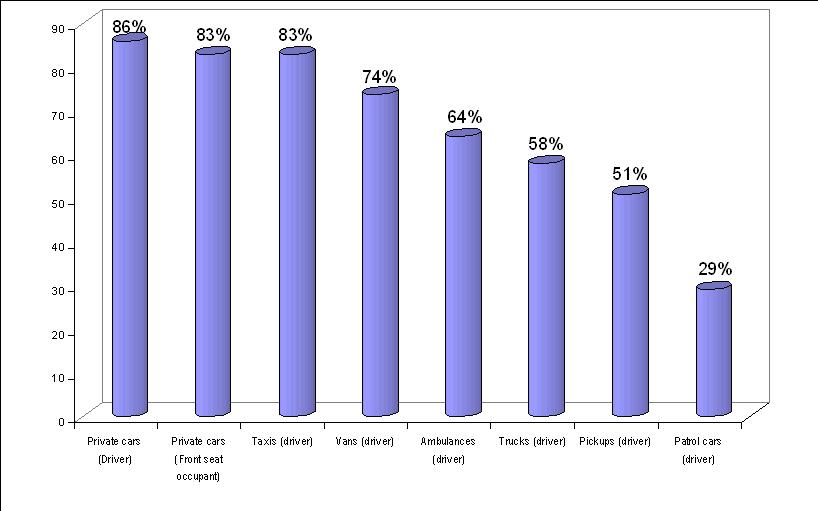
-Total of vehicles surveyed: 4276
-Days and times: Monday-Thursday, 8 am-6 pm and Friday, 8 am-1 pm.
-During the night, though no statistics were taken, usage is lower.
These results, with high seat belt use rates similar to those of developed countries (f.i. urban seat belts use rates in Canada, Sweden, New Zealand, Australia, etc. PRI, 1999), are caused, in our view, by two main factors:
1) This time, authorities not only said that there would be controls, but they announced it formally, publicized it with a certain start date, and, fundamentally, controls were visible and general on the previously announced date.
2) Many years of strong campaigns by Luchemos por la Vida on this subject led to a wide awareness of the general public, though, of course, as in the rest of the world, that final push was needed of control and possible punishment for them to put into practice something they already knew that was beneficial to protect their own lives, as shown in the following survey made by Luchemos por la Vida four days before enforcement started, with 487 Buenos Aires drivers who were asked about:

(Survey made among 487 drivers in the city of Buenos Aires. Date: 14-15 October 2004)
Usage was still high in the first month of enforcement:
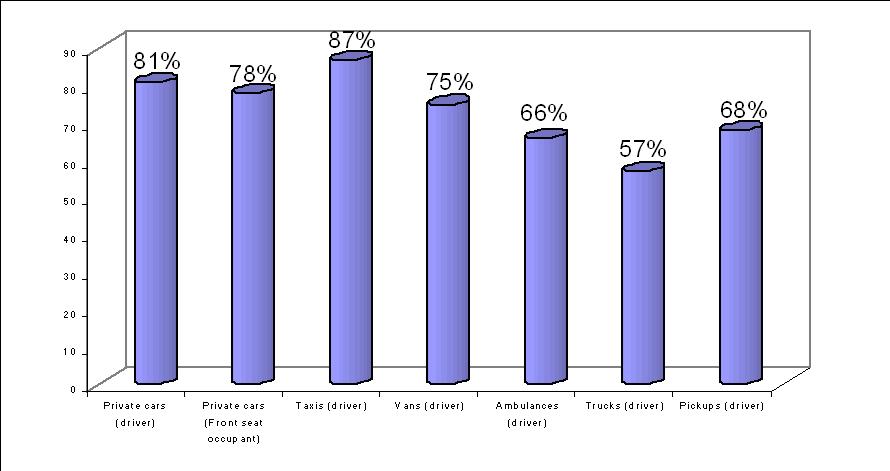
-Total of vehicles surveyed: 6,380
-Dates and times: Monday-Friday, 8 am – 6 pm
-No statistics were made at night nor on holidays, but a lower use percentage was generally observed.
However, the instability that characterizes policies and politicians in developing countries affected this process negatively: a tragedy, not connected to traffic safety, but very similar as to the lack of controls, prevention and enforcement of laws; the fire that destroyed the disco “Cromañón” and caused almost 200 fatalities, led authorities to dismiss many officials, among them, those who were in charge of the correct enforcement plan for seat belt use. Consequently, no further efforts were made to continue these controls, which, by February 2005, had almost disappeared.
The situation, at the close of this study (March 2005) shows that, despite the lack of enforcement, seat belt use has not dropped too significantly, as shown in the following graphic:
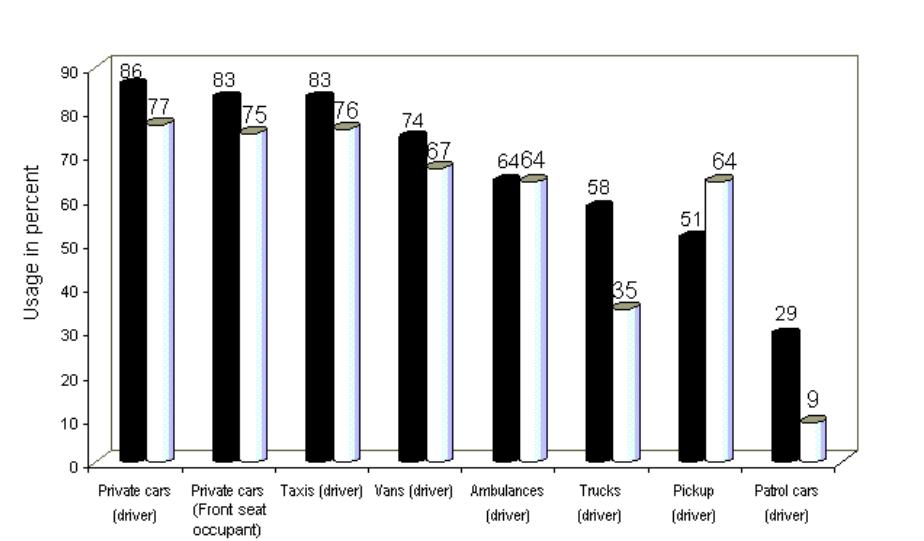
-Total of vehicles surveyed: 4,318
-Dates and times: Monday-Friday, 8 am – 6 pm
-No statistics were made at night nor on holidays, but a lower use percentage is generally observed.
CONCLUSIONS
We believe that the reasons for this rate to be high still are several:
1) The aforementioned process of creating awareness among the general public, which, after many years, and with the start of effective controls, leads to a permanent change where seat belt use becomes a permanent habit.
2) In itself, the repetition of the act of buckling up and seeing others buckled up leads many people to continue the habit, even when controls have been dropped, in which case there are more probabilities to keep the habit, provided the rest of the public does so as well.
Let me stress a very negative aspect in all this control process: despite our numerous complaints, the police officers in charge of punishing this kind of offense hardly ever wear seat belts themselves (as shown in our surveys). This constitutes a negative example to the general public, who sees that those in charge of controlling them are not convinced of the benefits of seat belt use or do not feel the need to comply with the law —that was made for them as well— when, in fact, they should be the first to comply; so, they lack the moral authority to punish others.
Since Buenos Aires is the most important city, the capital of the country, any example (good or bad) is copied by the rest of the nation.
So, the start of enforcement here caused other cities of the country to start their own seat belt use controls, which depend, mainly, on the continuity of controls in Buenos Aires.
This becomes fundamental if we keep in mind that researches made by Luchemos por la Vida show that, if we convince all the population to buckle up, we will save no less than 1,000 lives each year in Argentina.
To save those 1,000 lives each year, we need to keep the 77% seat belt use rate we have reached in the city of Buenos Aires and moreover, to increase usage even more. In order to do this, it is indispensable to reinstate controls that are general, permanent, visible, at any time of day and night, work days and holidays.
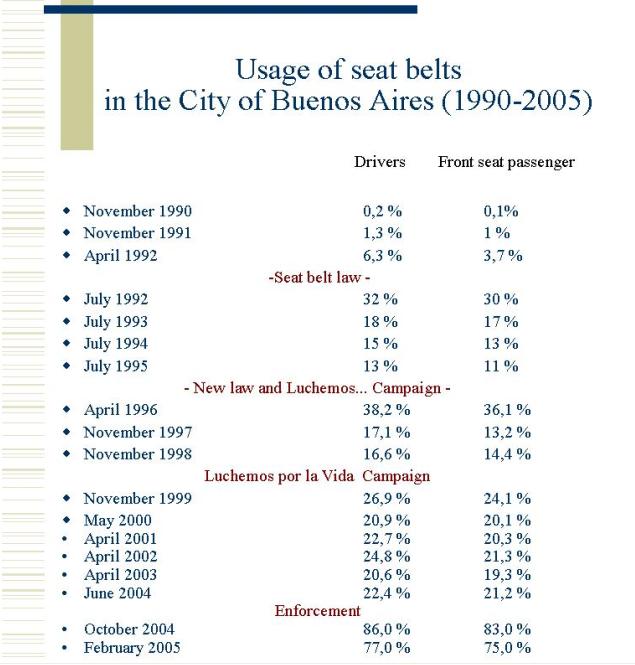
Table 1.
REFERENCES
-ADEFA (1993) Asociación de Fabricantes de Automotores, Argentina.
-Andréasson R. (1990) Arguments Against the Seat Belt and the Facts!, Proceedings of International Symposium on Road Traffic Accidents (1992) Riyadh, Saudi Arabia.
-Bäckström Claes-Göran and Andréasson Rune. The Seat Belt. Stockholm, April 2000.
-Campbell B.J. (1990) The Case for Laws Requiring Use of Safety Belts, Proceedings of International Symposium on Road Traffic Accidents (1992) Riyadh, Saudi Arabia.
-Elvik Rune (1991) Assessment of Road Accidents Costs. La Prévention Routière Internationale PRI. 8º World Congress, Portugal, Lisboa, 8-10 June 1998, Volume I.
-Evans L. (1987) Fatality Risk Reduction from Safety Belt Use. The Journal of Trauma, Vol. 27, No. 7, pp. 746-749.
-Ferguson Susan, (2003) Insurance Institute for Highway Safety. Status Report, Vol. 38, No. 1, January 11, 2003.
-Interamerican Developing Bank, (1998) Investigación sobre la Seguridad Vial en América Latina y el Caribe.
-Mackay M. (1991) The Effectiveness and Limitations of Seat Belts in Collisions, Proceedings of International Symposium on Road Traffic Accidents (1992) Riyadh, Saudi Arabia.
-Mercado Magazine (January 1993) Buenos Aires, Argentina
-NHTSA (1996) National Highway Traffic Safety Administration. Benefits of Safety Belts and Motorcycle Helmets: Report to Congress 1996. U.S. Department of Transportation: Washington DC.
-NHTSA (2000) National Highway Traffic Safety Administration. Cost of crashes in USA. Published in Status Report, Vol. 37 No. 7, Aug. 17, 2002.
-O´Neill Brian, (1993) Insurance Institute for Highway Safety. Status Report, Vol. 28, No. 6, May 15, 1993.
-PRI (1999) La Prévention Routière Internationale, Rate use of seat belts. Annual Report 1998-1999, No 1/1999.

